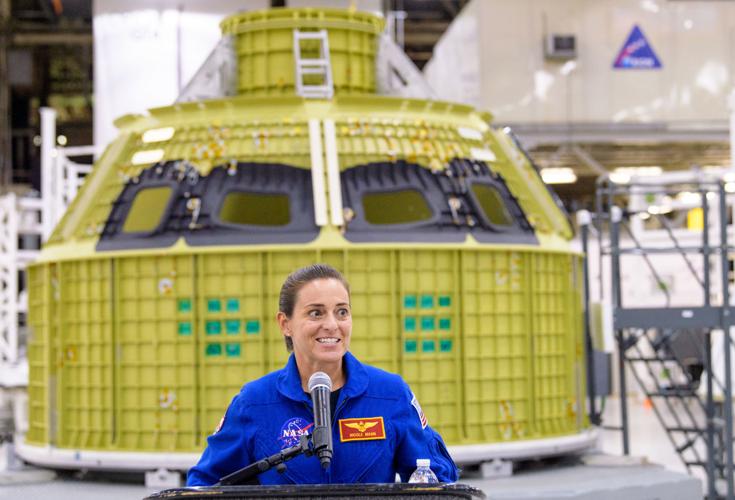Standing in a cavernous bay of the Michoud Assembly Facility's 2.2 million square feet of manufacturing space, NASA Administrator Jim Bridenstine said Monday that he is "very confident" that in 2020 the first of the massive liquid hydrogen tanks being built there will go farther into space than any human has ever been.
Louisiana doesn’t always come to mind when people think of America’s space legacy the same way that Texas and Florida do, but the most critica…
Bridenstine's comments came near the end of an hour-long tour of the facility, his first trip to the New Orleans East site since being confirmed as NASA's chief in April.
"This is our rocket factory," Bridenstine said. "Michoud is focused on SLS and Orion."
The first scheduled test flight of NASA's Space Launch System was originally scheduled for this year but has been delayed until at least late 2019. Mid-2020 is a more realistic target. That launch will be unmanned. A crewed mission is currently scheduled for 2023.
The Orion spacecraft will serve as the exploration vehicle that will carry the crew to space, sustain them there and bring them back safely. It will be launched on the SLS, NASA’s new heavy-lift rocket.
The SLS was first developed as a way to get humans to Mars, a plan that still exists. But under the Trump administration, that directive was refocused on the moon and building a sustainable presence there.
Americans should consider using any natural resources available on the moon as well, Bridenstine said.
As he spoke at the end of the tour, behind him lay one of the massive SLS fuel tanks. One tank, the larger, will be more than 130 feet long and will hold about 537,000 gallons of liquid hydrogen; the second will hold 160,000 gallons of liquid oxygen.
Both fuels must be kept liquid, which means they need to be super cold. The hydrogen must be kept at -423 degrees Fahrenheit; the oxygen must be kept at -293 degrees.
Construction of the tanks, which together help form what's known as the core stage of the rocket, is a central focus of the manufacturing effort at Michoud. The tanks are made by combining a series of cylinders, known as "barrels," capped at each end by a dome.
Those barrels are welded together in a room that is more than 200 feet high before being covered with a special insulating foam that keeps the fuels at the required temperatures.
It began with a thump that was felt rather than heard, followed by a roaring hiss. Then massive plumes of steam shot out of the bottom of the …
Elsewhere in the massive Michoud facility, engineers and astronauts are working on a far smaller but more intricate part of getting humans off the planet. The Orion space capsule bears a resemblance to its Apollo program forebears but is different in many ways, said Scott Wilson, a NASA program manager.
"Physics drives you to a certain shape," he said. But the technology is vastly different. The Orion will use solar arrays and batteries instead of fuel cells, which will give it far longer life. Its avionics — the systems that control how it flies — will be vastly superior to those on the Apollo missions.
Perhaps most notable to its pilots, the Orion is bigger than the Apollo crew capsule. The first of the Orion capsules, for the 2020 mission, has already been sent to the Kennedy Space Center in Florida. The second, the one that will be used for the manned mission in 2023, is currently being built at Michoud.
Sending missions to the moon and beyond is a key to American foreign policy, Bridenstine said.
Can't see video below? Click here.
Taking such a scientific lead is an effective tool of "soft power" and diplomatic leverage that can only help the United States, he said. And while he said he supports President Donald Trump's desire to create a new armed service to be called the Space Force, he stressed that NASA's mission is scientific in nature.
"We do science, we do discovery, we do technology, we do exploration," Bridenstine said. He said he wants to keep NASA apart from national security or defense operations. "We want partners from around the world."
He also noted that some of those partners would be private companies like SpaceX or Virgin Galactic or Blue Origin.
"We want to be one among many customers and we want many providers," he said. The proliferation of private space companies — all of which are currently working on low-earth orbit projects — helps NASA focus on major deep-space projects.
If it works as planned, the first SLS missions will slingshot away from the Earth toward the moon before swinging out wide in a moon orbit, going farther from the Earth than anyone ever has before returning to Earth and splashing down in the Pacific Ocean.
"This isn't flags and footprints," Bridenstine said. "For us it's not just to get to the moon, but to stay at the moon."
Depending on Wednesday's weather, a crew of six could embark this week on a different kind of NASA mission: a nearly two-week, 1,240-mile jour…
Recent tenant expansions at NASA's Michoud Assembly Facility have spurred nearly 250 new jobs in the aerospace and advanced manufacturing sect…













